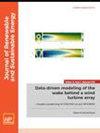不同转子构型倒锥垂直轴风力机气动性能研究
IF 1.9
4区 工程技术
Q4 ENERGY & FUELS
引用次数: 0
摘要
海上风电资源丰富。垂直轴风力发电机(VAWTs)由于其低成本和高可靠性而适合在海洋环境中工作。本文提出了一种海上浮动倒锥垂直轴风力机。采用三维非定常计算流体力学(CFD)方法对ICVAWT进行建模。采用湍流模型SST k−ω求解Navier-Stokes方程,确定了求解器和独立网格的设置参数。利用相似理论设计了比例实验样机,并进行了风洞实验。实验结果验证了CFD模型的有效性。利用CFD模型分析了9种构型的气动性能,研究了倒锥角和叶片数对ICVAWT功率系数和运行稳定性的影响。研究发现,当倒锥角为45°,叶片数为3(称为最佳配置)时,功率系数最高,为0.309(最佳叶尖速比为3.5)。随着倒锥角和叶片数的增加,风力机运行转矩波动减小。根据流场中各物理量的分布,解释了气动性能的变化。对优化后的结构进行了进一步的研究。本文章由计算机程序翻译,如有差异,请以英文原文为准。
Study on aerodynamic performance of inverted cone vertical axis wind turbine with different rotor configurations
Offshore wind resources are abundant. Vertical axis wind turbines (VAWTs) are suitable for working in the sea environment because of their low cost and high reliability. In this paper, an offshore floating inverted cone vertical axis wind turbine (ICVAWT) is proposed. The 3D unsteady computational fluid dynamics (CFD) method is utilized to model the ICVAWT. The turbulence model SST k−ω is used to solve the Navier–Stokes equation, and the setting parameters of the solver and the independent grid are determined. The scale experimental prototype is designed using the similarity theory and the wind tunnel experiment is carried out. The experimental results verify the validity of the CFD model. The aerodynamic performance of nine ICVAWT configurations is analyzed by using the CFD model, and the effects of inverted cone angle and blade number on the power coefficient and operation stability of the ICVAWT are studied. It is found that when the inverted cone angle is 45°, and the number of blades is three (called the optimal configuration), the power coefficient is the highest at 0.309 (the optimal tip speed ratio is 3.5). With the increase in inverted cone angle and blade number, the fluctuation of wind turbine operating torque decreases. According to the distribution of each physical quantity in the flow field, the changes in aerodynamic performance are explained. Further research on the optimized configuration is carried out.
求助全文
通过发布文献求助,成功后即可免费获取论文全文。
去求助
来源期刊

Journal of Renewable and Sustainable Energy
ENERGY & FUELS-ENERGY & FUELS
CiteScore
4.30
自引率
12.00%
发文量
122
审稿时长
4.2 months
期刊介绍:
The Journal of Renewable and Sustainable Energy (JRSE) is an interdisciplinary, peer-reviewed journal covering all areas of renewable and sustainable energy relevant to the physical science and engineering communities. The interdisciplinary approach of the publication ensures that the editors draw from researchers worldwide in a diverse range of fields.
Topics covered include:
Renewable energy economics and policy
Renewable energy resource assessment
Solar energy: photovoltaics, solar thermal energy, solar energy for fuels
Wind energy: wind farms, rotors and blades, on- and offshore wind conditions, aerodynamics, fluid dynamics
Bioenergy: biofuels, biomass conversion, artificial photosynthesis
Distributed energy generation: rooftop PV, distributed fuel cells, distributed wind, micro-hydrogen power generation
Power distribution & systems modeling: power electronics and controls, smart grid
Energy efficient buildings: smart windows, PV, wind, power management
Energy conversion: flexoelectric, piezoelectric, thermoelectric, other technologies
Energy storage: batteries, supercapacitors, hydrogen storage, other fuels
Fuel cells: proton exchange membrane cells, solid oxide cells, hybrid fuel cells, other
Marine and hydroelectric energy: dams, tides, waves, other
Transportation: alternative vehicle technologies, plug-in technologies, other
Geothermal energy
 求助内容:
求助内容: 应助结果提醒方式:
应助结果提醒方式:


